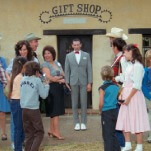Comic-Con, Day 4: Artists' Alley
When Al Wiesner looked at the superhero landscape in the late '80s, he thought something was missing: Judaism. Naturally, he responded by creating his own superhero, a strange rock-turned-man called Shaloman. Shaloman rides the uneasy line between parody and straight-up superhero comic, and it's never immediately clear if even Wiesner knows his true intentions, outside of one issue, his favorite, which he constantly refers to as "the parody issue." But the parody issue doesn't look appreciably different from the regular issues, outside of jokes like "Nosir Nyafat." ("Instead of Yassir Arafat," he says.) Behind him, a woman I take to be his wife is digging into a bagel and lox. She's tired. He's tired. Last day of Comic-Con, and the last chance to pitch Shaloman to people like me, who stop by, curious about what the hell "Shaloman" could mean. Prices have been drastically reduced, and he assures me, once he sells out issue 1, he will print no more, not like Marvel or the other big boys. The woman just stares into the middle distance.
I'm in Artists' Alley, one of the elements that the original San Diego Comic-Con grew out of years and years ago. This was the place for comics artists to set up booths to show off their artwork and network with each other. Over the decades, it's shifted from the center of the convention to the far corner of the show floor. Has it gotten smaller? Larger? I get different answers from different people, and I think the truth lurking behind the conflicting statements is that the Artists' Alley section of the Con has gotten definitively larger, in the sense of size and area, but has gotten smaller in terms of how important it is to the show. Now at the center of the show floor, as near as I can tell, is a perfect recreation of Bumblebee from the Transformers movies.
Creativity always, always gets shunted aside by commerce. It shouldn't be as depressing as it is, but the constant reminders of this fact in seemingly every aspect of our lives somehow don't stop feeling like new, fresh stabs at the vital part of ourselves that demands something GOOD, for God's sake. Something true and original and bold and precious, something driven by a person or small group of people that has something to say, even if that something to say is as basic as, "I wish there were a Jewish superhero." There's a reason so many movies pitch the scrappy underdogs beating the giant, corporate behemoth, beaming with pride at the end as the big guys realize that they were wrong all along. There's also a reason these movies have multi-million dollar advertising budgets.
I keep trying to slot Artists' Alley into my preferred story of the Con: Artists' Alley has gotten less and less important as time has gone by because the organizers behind the Con made a deal with Hollywood to bring in panels geeks might be interested in, then let the money Hollywood brought lead them down a path paved with good intentions but ultimately leading to ruin. The problem, though, is that this story just isn't true. Every artist I talk to says that having more people at the Con means more people wander by their booths, means more of them stop to talk, means more of them buy sketches or merchandise or stuff. Having more people visit the booth allows them to float along on commissions or sketch sales until one of the comics companies comes calling, and having a very popular booth is also a potential way to attract the attention of those companies.
The comics industry, for the most part, is sort of like that "Gotta Dance" number in Singin' in the Rain, at least to hear some of these people tell it. It's all about knocking and knocking on doors until someone answers and sees you and likes what you have to offer. Obviously, it's not like that completely, and it's not nearly so egalitarian, but the industry remains small enough that someone like a Chrissie Zullo – whose covers for a Fables miniseries have been justly celebrated – can get a job simply by sending an attractive image as an e-mail attachment. Sure, she has to find that e-mail address somewhere, and she has to have the talent, but there's a sense that these doors are easier to knock on than the doors in other entertainment industries. (Granted, the people I talk to have mostly broken through. For many with talent who haven't broken in, it must feel as impossible as winning So You Think You Can Dance? feels to me.)
I talk to Richard Peter Han, who's here with his creation, Sprocket and Gear, which is a tale of a friendly cat and rat who use crazy inventions to accomplish their tasks. Han's sketches of the characters burst with color and life, and somehow combine the influences of cute animal cartoons, early Disney, Depression-era comic strip street scenes, and the inventions of Leonardo da Vinci into a blend of influences that feels new. The sketches, at least, are enough to make me want to see a full comic featuring the two characters. Han's hoping to turn them into a TV series. He came out of video games, and he'd like to break into that industry. All along, his high school art teacher sits off to the side, a quiet smile on her face. She knows this stuff is good. She knows he's got the initiative. Sprocket and Gear will likely go somewhere. Han just has to find the right medium for his characters.






![HBO teases new Euphoria, Larry David, and much more in 2026 sizzle reel [Updated]](https://img.pastemagazine.com/wp-content/avuploads/2025/12/12100344/MixCollage-12-Dec-2025-09-56-AM-9137.jpg)

































